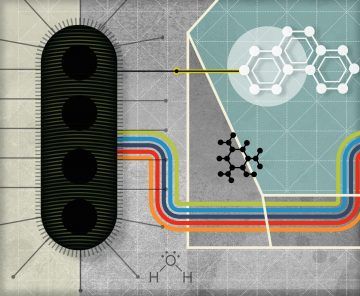Carl Zimmer in The New York Times:
 At three o’clock in the afternoon on September 4, 1882, the electrical age began. The Edison Illuminating Company switched on its Pearl Street power plant, and a network of copper wires came alive, delivering current to a few dozen buildings in the surrounding neighborhood. One of those buildings housed this newspaper. As night fell, reporters at The New York Times gloried in the steady illumination thrown off by Thomas Edison’s electric lamps. “The light was soft, mellow, and grateful to the eye, and it seemed almost like writing by daylight,” they reported in an article the following day. But nature invented the electrical grid first, it turns out. Even in 1882, thousands of miles of wires were already installed in the ground in the New York region — in meadows, in salt marshes, in muddy river bottoms. They were built by microbes, which used them to shuttle electricity. Electroactive bacteria were unknown to science until a couple of decades ago. But now that scientists know what to look for, they’re finding this natural electricity across much of the world, even on the ocean floor. It alters entire ecosystems, and may help control the chemistry of the Earth.
At three o’clock in the afternoon on September 4, 1882, the electrical age began. The Edison Illuminating Company switched on its Pearl Street power plant, and a network of copper wires came alive, delivering current to a few dozen buildings in the surrounding neighborhood. One of those buildings housed this newspaper. As night fell, reporters at The New York Times gloried in the steady illumination thrown off by Thomas Edison’s electric lamps. “The light was soft, mellow, and grateful to the eye, and it seemed almost like writing by daylight,” they reported in an article the following day. But nature invented the electrical grid first, it turns out. Even in 1882, thousands of miles of wires were already installed in the ground in the New York region — in meadows, in salt marshes, in muddy river bottoms. They were built by microbes, which used them to shuttle electricity. Electroactive bacteria were unknown to science until a couple of decades ago. But now that scientists know what to look for, they’re finding this natural electricity across much of the world, even on the ocean floor. It alters entire ecosystems, and may help control the chemistry of the Earth.
“Not to sound too crazy, but we have an electric planet,” said John Stolz, a microbiologist at Duquesne University in Pittsburgh. In the mid-1980s, Dr. Stolz was helping to study a baffling microbe fished out of the Potomac River by his colleague Derek Lovley. The microbe, Geobacter metallireducens, had a bizarre metabolism. “It took me six months to figure out how to grow it in the lab,” said Dr. Lovley, now a microbiologist at the University of Massachusetts at Amherst.
More here.
